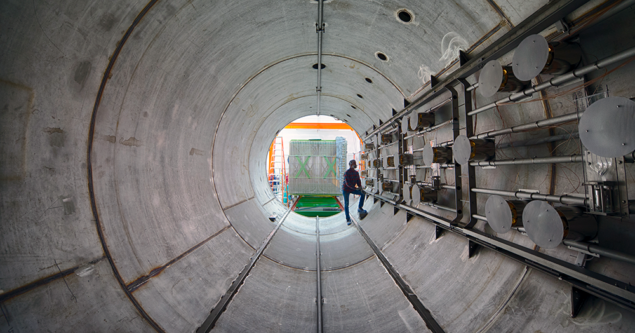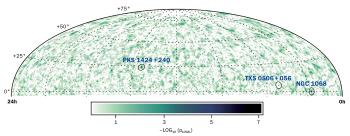
The existence of an eV-scale sterile neutrino looks less likely today than at any time in the past 20 years. Such a particle has long been considered to be the simplest explanation for several related anomalies in neutrino physics, but results released yesterday by Fermilab’s MicroBooNE collaboration disfavour its existence relative to the Standard Model.
“MicroBooNE has made a very comprehensive exploration through multiple types of interactions, and multiple analysis and reconstruction techniques,” says co-spokesperson Bonnie Fleming of Yale. “They all tell us the same thing, and that gives us very high confidence in our results that we are not seeing a hint of a sterile neutrino.”
The collaboration says that the analyses favour the Standard Model over the anomalous signal seen by sibling-experiment MiniBooNE at more than 99% confidence, should its true origin be electrons from a neutrino oscillation via a hitherto-undetected sterile neutrino. “But that earlier data from MiniBooNE doesn’t lie,” says former co-spokesperson Sam Zeller of Fermilab. “There’s something really interesting happening that we still need to explain.”
There’s something really interesting happening that we still need to explain
Sam Zeller
Neutrinos suffer from an identity crisis regarding their mass. As a result, the three known flavours morph into each other as phase differences develop between three mass eigenstates. However, well before this model solidified around the turn of the millennium, a measurement by the LSND collaboration at Los Alamos in the US suggested the existence of an additional neutrino which had to be “sterile” with respect to the weak, electromagnetic and strong interactions, and much more massive, given how rapidly the oscillation developed. Since this first hint, the tale of the sterile neutrino has taken multiple twists and turns.
Twists and turns
In the mid-1990s, LSND reported seeing a 3.8σ excess of electron antineutrinos in a beam of accelerator-generated muon antineutrinos, but the KARMEN experiment at the Rutherford Appleton Laboratory in the UK failed to reproduce the effect. Evidence for an eV-scale sterile neutrino mounted with the observation of a deficit of electron neutrinos from 37Ar and 51Cr electron-capture decays at Gran Sasso in Italy and at the Baksan Neutrino Observatory in Russia (the gallium anomaly), and a reported deficit of electron antineutrinos from nuclear reactors (the reactor anomaly). Troublingly, however, long-baseline accelerator neutrino experiments such as MINOS+ do not observe the requisite “disappearance” of muon neutrinos required by the principle of unitarity, and the existence of such a sterile neutrino is also starkly incompatible with current models of cosmology. While the gallium anomaly should soon be probed definitively by the BEST experiment at Baksan (Phys. Rev. D 2018 97 073001), recent calculations of reactor fluxes may now be dissolving the reactor anomaly (see, for example, arXiv:2110.06820). But the most compelling single piece of evidence in favour of sterile neutrinos came when the MiniBooNE experiment at Fermilab tried to reproduce the LSND effect. In November 2018, the collaboration reported a 4.5σ excess of electron neutrinos and antineutrinos compared to Standard-Model expectations.
Few neutrino physicists foresaw that MicroBooNE would disfavour both hypotheses
Sibling experiment MicroBooNE has now released its first round of tests of the MiniBooNE anomaly. Equipped with a cutting-edge liquid-argon time-projection chamber, the collaboration observed neutrino interactions at the level of individual particle tracks – a key advantage compared to a Cherenkov detector such as MiniBooNE, which could not distinguish electrons from photons. The collaboration has now used half of its available data to probe which particle is the true origin of the anomaly. Earlier this month, MicroBooNE tested the hypothesis that MiniBooNE’s excess was actually due to an underestimated single-photon background, perhaps caused by a difficult-to-model rare decay of a Δ resonance. Now, MicroBooNE has tested the hypothesis that the MiniBooNE excess was caused by single electrons, most likely the result of neutrino oscillations via an eV-scale sterile neutrino. Few neutrino physicists foresaw that MicroBooNE would disfavour both hypotheses.
“Every time we look at neutrinos, we seem to find something new or unexpected,” says MicroBooNE co-spokesperson Justin Evans of the University of Manchester. “MicroBooNE’s results are taking us in a new direction, and our neutrino programme is going to get to the bottom of some of these mysteries.” The collaboration will now investigate whether more exotic topologies such as electron-positron pairs could be the source of the MiniBooNE anomaly. Such a final state might suggest the existence of heavier sterile neutrinos, say theorists.
“eV-scale sterile neutrinos no longer appear to be experimentally motivated, and never solved any outstanding problems in the Standard Model,” says theorist Mikhail Shaposhnikov of EPFL. “But GeV-to-keV-scale sterile neutrinos – so-called Majorana fermions – are well motivated theoretically and do not contradict any existing experiment. They can explain neutrino masses and oscillations, give a dark-matter candidate, and produce a baryon asymmetry in the universe: all the problems that the Standard Model is incapable of addressing. Experimental efforts at the intensity frontier should now be concentrated in this direction.”








